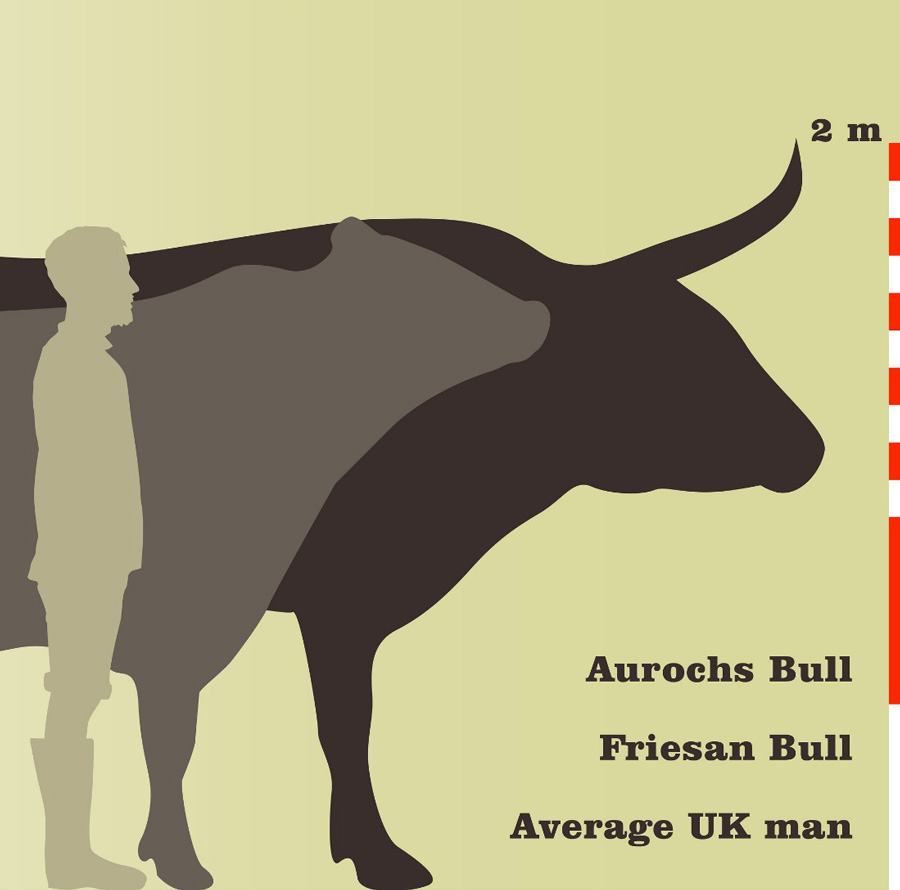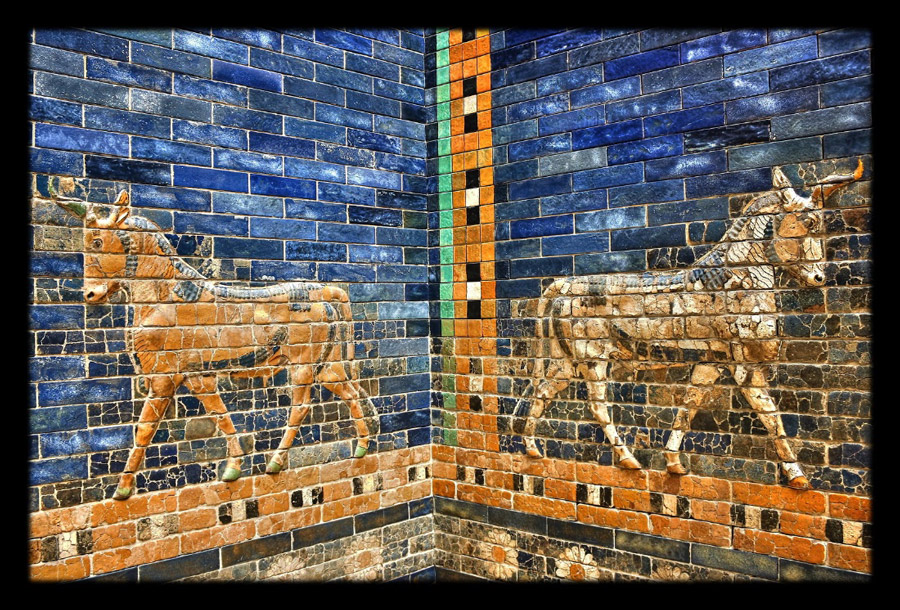All present day cattle descend from one giant, extinct ancestor: the aurochs. This giant bovine had a wide range, including areas like North America, Europe, and Asia. and they survived until relatively recently, with European examples in existence as late as 1627. By that point, these mega cows had been shaping the ecosystem for about 2 million years. Some ecologists even want them back, believing that their comeback is essential in order to protect biodiversity in different parts of Europe.
Physical Appearance
In order to reconstruct the physical appearance of the giant cow, historical descriptions, skeletal material, and contemporaneous reconstructions have been used. Prehistoric cave paintings often depict the Aurochs, and Julius Caesar’s “The Gallic Wars” has numerous descriptions as well.
Both agree that the Aurochs were one of the largest herbivores found in postglacial Europe. It has some similarities with another ice age survivor, the European bison. Aurochs differed in size across their range, with northern European specimens being bigger than the ones found in the south.
The average height of the Aurochs in Germany and Denmark at the shoulder ranged up to 180 cm (71 inches), compared to the Hungarian Aurochs which grew only up to 160 cm (63 inches). Their body mass also varied.

The Aurochs were also known to be one of the heaviest land mammals, weighing up to 1500 kg (3,300 pounds). Despite this weight, they were powerful, agile and athletic animals, well capable of defending themselves against different predators like wolves. Their long legs also allowed them to cover long distances at a time.
While the modern cattle are known to be the descendants of Aurochs, the body shape and proportions of aurochs were quite different from them. The Aurochs had more slender and long legs. The skull and the large horns was more elongated and substantially larger compared to the present cattle breeds.
Their body shape was much leaner and athletic, and the bulls had a clearly visible shoulder and neck musculature. This carried through to the massive head, where unlike most modern domesticated cattle, the Aurochs had a large forehand for charging.
The Aurochs, especially the bulls, possessed truly massive horns, stretching out from these broad and elongated frontal bones. Their horns were extremely impressive, curving outwards at the base before swinging upwards and inwards. They could be up to 20 cm (8 inches) in diameter, growing about 80 cm (31 inches) long.
We are even able, thanks to the historical depictions, to guess what coat color the Aurochs had. According to the cave paintings, the calves initially were a chestnut color. However, when the calves grew into young bulls, their coat color changed to black, with long white stripes running down their spine. On the other hand, the cows appear to have been reddish-brown.
One thing that was common between the cows and bulls was the light-colored muzzle: the Aurochs apparently had a curly, blond forehead.
A Furious Fighter
One of the most prominent and frequently mentioned traits of the Aurochs was that of their fighting prowess. Both the cows as well as the bulls were aggressive and willing to fight, although the bulls usually had more severe fights, typically during the mating season in early autumn or late summer.

Evidence shows that these fights could be deadly, especially among bulls, and research suggests that the Aurochs would put on muscle and fat in the autumn months to prepare themselves. The calves were born during the spring and stayed at the cow’s side until they became strong enough to join the herd.
The young calves would be vulnerable to attacks, typically from brown bears and grey wolves but also from tigers, lions, and even hyenas. However, the adult Aurochs did not fear any predators due to their size and strength.
In addition to being fast and swift, the Aurochs were also very aggressive at times. While the presence of human beings did not normally affect the Aurochs, they could get dangerous and aggressive if they were being hunted, or even teased. Throwing a full-size human into the air was entirely possible for these massive animals.
Adaptable And Successful
Not much information about the habitation of these giants is available. But it is believed that the Aurochs easily adapted to a number of different ecosystems in Europe, living in forests, swamps, mountains, and frozen steppes.
The European landscape at the time mainly had dense forests, and the size of Aurochs horns suggests they may have preferred the open areas. Recovered bones of the extinct mammals also show that they lived in marshes and floodplain forests, much wetter than conditions tolerated by modern cattle.
At one point in time, the giant cows lived in various regions of Europe, the Middle East, Northern Africa, East and Central Asia, and India. Three thousand years ago, the Aurochs were even found in eastern China. Fossils from the Japanese archipelago and Korean Peninsula also show the existence of the Aurochs.
But by the time of their final centuries, the Aurochs were limited to living in the remote regions of northeastern Europe. This was driven by one factor: the steady growth of the human population.
Culture And Power
In early cultures, the Aurochs were considered a symbol of strength. They also became synonymous with hunting, and the honor of the successful kill, as they appear to be an important game animal that appeared in a number of Mesopotamian and Palaeolithic European cave paintings.

A number of archaeological excavations also show the involvement of the Aurochs as a religious sacrifice. The Roman Mithraic cult of 2,000 years ago was based around the symbolic killing of a bull.
Seals found in Mohenjodaro and Harappa (in Pakistan) depict an animal in profile. While it is sometimes considered to be a unicorn, it most probably represents the Aurochs. The curved horns of the animal on the seal may represent two horns of an aurochs when seen from one side.
During antiquity, this giant and aggressivespecies were known to have a significant cultural value. The Ishtar Gate has depictions of Aurochs, greeting visitors to the inner city of Babylon, and there are a number of references to the Aurochs in the Hebrew Bible. The huge horns of the Aurochs were used as wine cups, trophies, and offerings to the heroes and gods.
When the Aurochs started becoming rare, it was considered as a privilege to hunt them, restricted to people of high social status. The Aurochs itself increased in status, by association.
Royalty would use the horns of Aurochs as their drinking horns, and in central Europe the giant cows are often featured on heraldic coats of arms, including those of Moldavia, Moldova, and Romania.

In Estonia, Aurochs are also a popularly used symbol. In the Estonian town of Rakvere, a huge Aurochs statue was unveiled to celebrate the 700th birthday of the town. Later, the sculpture became the symbol of the town.
An Ancient Ecosystem Stabilizer
Are you wondering how the Aurochs could play a vital role in saving the ecosystem? Well, they can, and they actually did. According to the research, the Aurochs had a positive impact on the biodiversity of Europe and halted habitat loss.
For thousands of years, the large herbivores browsed and grazed the lands of Europe, thereby creating more open spaces for others to survive. These heavyweight mammals fed largely on vegetation and prevented the different landscapes falling to thick forest. After grazing, their manure enriched the soil churned up by their hooves, making it easy for the plants to sprout.
Domestication: Then And Now
These were not strictly wild animals, either. A number of studies have produced evidence that shows attempts to domesticate the Aurochs, dating back 8,000 to 10,000 years ago. Domestication of the giant cows actually began in northern Mesopotamia and the southern Caucasus.
- Tennessee Town Hangs Murderous Mary the Elephant
- Orang Pendek: Is There An Unknown Great Ape In Remotest Sumatra?
As a domesticated food source and beast of burden, the Aurochs is known to have helped human beings in a number of ways. Their domestication was considered to be a central pillar of agricultural development and civilization.
The peoples of the middle eastern “Fertile Crescent,” as well as a number of Indian civilizations, relied on Aurochs in order to produce dairy products, meat, and leather. They even helped in the transportation of goods and people, although they never lost their fire and stubbornness.
Extinction
By the 5th century BC, the Aurochs had already disappeared from southern Greece, although they remained common in the Echedorus river area to the north. But their numbers continued to decline, and by the time of the 13th century AD, they were limited to Lithuania, Poland, East Prussia, and Transylvania.
According to the archaeological data, the Aurochs survived in northwestern Transylvania until the 14th to 16th century AD. They survived even longer in Romanian Moldova, and Bulgaria around Sofia until the 16th and 17th centuries. But the writing was on the wall.

As the number of Aurochs started decreasing, hunting and poaching the giant cows became a punishable crime. However, this did not seem to have the desired effect, and over-hunting was one of the main reasons for the decline of Aurochs.
Other potential reasons for their decline included degradation of their habitat due to agricultural advances, and infection by different diseases from domesticated livestock. With the passage of time, the range of Aurochs became more and more restricted, until only a small population of the animal was left in the royal hunting reserve in the Forest of Jacktorów in Poland.
According to the records, the last Aurochs was a female that lived in the Jaktorów Forest. It died in 1627 due to natural causes.
Do We Want Them Back?
The concept of recovering the species was first suggested by Feliks Paweł Jarocki in the 19th century. However, the first real attempt to breed back the Aurochs was only made in 1920 by the Heck brothers in Germany.
Lutz and Heinz Heck started a selective breeding program in order to bring back Aurochs with the help of their descendants, along with domesticated cattle. Their whole program was based on the idea that a species is actually not extinct until its genes are no longer present in any living population.
The breeding program of the Heck brothers led to the development of the species known as “Heck cattle.” According to scholars, the Heck cattle resemble the physical appearance of Aurochs.
In 1966, a conservation group named Arbeitsgemeinschaft Biologischer Umweltschutz in Germany made an attempt to crossbreed Heck cattle with other primitive breeds of southern Europe. The main aim was to increase the aurochs-likeliness of some herds of Heck cattle.
The resultant crossbreed was known as Tauros cattle. The crossbreeding mainly aimed at improving the aurochs-like features that were known to be missing in the Heck cattle.

Various other such projects were taken by different researchers in order to breed back the giant cows for the betterment of the ecosystem. Some of the prominent projects included the Tauros project, Auerrind Project, and the Uruz project.
The scientists have succeeded to a certain extent. With the evolution of modern biotechnology and genetics, scientists believe that it is possible to effectively recreate animals that are similar to the Aurochs. And once again Europe can be home to the giant, murderous bovine that lived here for 2 million years, before humans wiped it out.
Top Image: German “Heck cattle” are a modern attempt at recreating the Aurochs. Source: rudiernst / Adobe Stock.
By Bipin Dimri